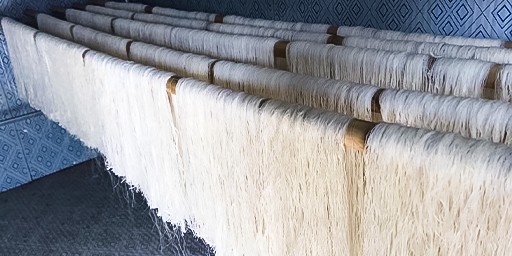Use an air source heat pump to dry rice noodles, no longer have to worry about the rainy season
With the maturity of air source heat pump drying products and market promotion, agricultural and sideline products have become their main application field, and rural areas have naturally become the main battlefield for heat pump drying. In rural areas, affected by traditional agricultural thinking, most of the agricultural and sideline products and food are still dried in natural drying. Still, there are problems such as being affected by the weather, secondary pollution, and the high cost of artificial drying.
A rice noodle processing factory in Zhejiang is located in a mountainous area. It is a small workshop with a small daily output and mainly sells to nearby rural markets. For a long time, customers have adopted the form of natural drying, hanging rice noodles on bamboo poles outside to let the sun dry. However, there have always been some problems. One is that due to the weather, it cannot be dried on rainy days or takes many days to dry, which affects normal production; the other is that outdoor drying requires a large space, and manual hanging and recovery are required. The third is that it will bring secondary pollution to rice noodles. There are many mosquitoes outdoors, and once it rains or winds, the surface of rice noodles will be stained with dust. Therefore, customers have been having headaches due to the problem of dry rice noodles, and have not found a more suitable method. Some nearby processing factories use coal-fired furnaces for drying, but the dust is very large, it is very unsanitary, and the quality of rice noodles is not good, so I did not learn from their methods.
Some time ago, the continuous rainy weather in the Zhejiang area had a serious impact on the processing plant, and the output dropped sharply. In order to ensure normal production, the person in charge of the processing factory is actively looking for new drying methods. Through a friend’s introduction, he came into contact with air energy, thinking that air energy can be used to dry Chinese herbal medicines, so it should also be able to dry rice noodles. So after detailed communication, the person in charge decided to try heat pump drying.
After inspecting the processing factory, the person in charge built a heat pump drying room according to the daily output of rice noodles, equipped with a 7p air source heat pump dryer. After 4 days of intensive construction, the project was successfully completed. Afterward, the customer conducted a trial baking, and the effect was very good. The temperature and humidity were easy to control, the effect was good, and the customer’s satisfaction was achieved at one time. The customer said: “The air-drying effect is really good. I have seen it from some colleagues. They use coal-fired drying to generally reflect the color and taste. And it is very convenient to use, which saves a lot of labor costs compared to before.”
According to the person in charge, rice noodles are suspended materials. It is best for the fan to blow in the direction of the material. It is difficult to fix the fan. Depending on the region and the type of rice noodles, the drying temperature and time vary. The rice noodles are small, so the drying temperature should not be too high, as it will easily change color if it is too high, just simulate the summer sun temperature, and give enough air volume and dehumidification time. The rice noodles dried by heat pump do not change color, do not break, have uniform dryness, good color, good taste, and good rehydration. Rice noodle drying is generally divided into the following three stages:
low-temperature stage. The mode is drying and dehumidification. The surface moisture of the rice noodles is removed as much as possible in this stage, and the temperature of the rice noodles is gradually increased to make the temperature of the inside and outside of the rice noodles consistent. The temperature in this range is generally set at about 25°C.
high-temperature stage. After the rice noodles enter the high-temperature stage, the internal water is gradually evaporated and discharged out of the rice noodles. The rice noodles are evenly dried and formed well. The water content of the rice noodles entering the cooling zone is basically kept at about 13%, and the temperature in this section is controlled at 35 At around ℃, be careful to avoid bursting caused by excessive moisture.
cooling phase. After entering the cooling stage, the drying process of rice noodles is basically completed. This stage is a process of decreasing temperature, and the temperature is controlled according to the climate conditions and the actual dry and wet conditions of rice noodles. Keep the temperature decreasing to prevent the rice noodles from cooling down too quickly, so that the surface temperature of the rice noodles will not be too low, and the internal temperature will be high, resulting in air bubbles, which are often called pollen, and the rice noodles will not burst.
The general drying time of rice noodles is 6 to 8 hours. The most important thing in the early stage of drying rice noodles is that the temperature should not be too high. Although the temperature is high, it will dry quickly, but it is easy to cause the rice noodles to turn yellow, the color is not good, and the taste will also deteriorate. The temperature during the whole operation process should not exceed 45 degrees. If the temperature is high, the finished product will be easily broken.



